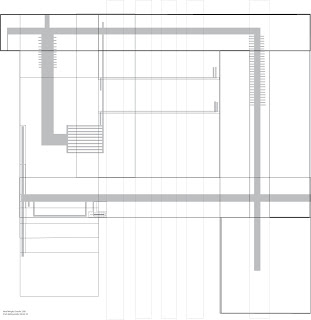1. How does Peter Zumthor talk about the "Magic of the Real" and explain how this compares, in terms of the subtleties, to Michael Benedikt's "Architecture for Reality"?
Zumthor discusses the "Magic of the Real" being comparable to music as something that can touch a human being. This phenomenon was something that Zumthor strived for in his architecture. This has a connection to the discussion that Benedikt had concerning architecture being like a piece of fine art that must sit in its frame in a predictably poised manner. The subtle connections of these two men's thoughts lie in the comparison of an architectural work to something more "realistic" in that it exists on the tangible human scale.
2. Material Compatibility, Temperature of a Space and Levels of Intimacy are some conditions that both Peter Zumthor, in “Atmospheres”, and Richard Serra, in “Weight and Measure”, make a point of articulating when consider space. Where in their explanation of these overlapping conditions are they similar and where do they differ?
Peter Zumthor speaks of material, temperature and intimacy as a reaction of a person moving through a space. These types of things are said to present themselves in an organized fashion in such a way that one can form an immediate opinion about the space in question. He also discusses the owner's role in organizing the material, especially and how that role can have a unique effect on the space itself.
Serra differs in that he concentrates mainly on the materials as a sculptor. In considering the metal piece that he was to install in the Duveen Galleries, Serra had to take into account what shape the form needed to take. He had to consider the vertical rise of the pre-installed spatial elements as well as a series of niches and the overall vertical changes of the space. These considerations are not unlike the attention Zumthor speaks of when creating a first impression of sorts with his architecture. Both Peter Zumthor and Richard Serra seem to strive for the "immediate appreciation" that Zumthor brings up when they are creating work. All the choices concerning temperature, intimacy and material contribute to the experience that one has thus, they must be considered in design.
3. Zumthor looks towards experiential conditions when creating architecture, what are other methods architects use when generating architecture and what is the corresponding building?
In the same way that Zumthor looks at the overall experiential quality of a building, Alex Jordan considers the overall site just as much as the interior perspective. In designing "The House on the Rock" Jordan relied heavily on the piece of land that originally caught his eye to dictate what he would build on it. In this way the overall structure harmonizes with the site conditions. Where there is an organic vertical rise, the structure experiences a vertical rise in an organic style (such as a steeply sloping ramp to follow a hill structure). This patterning is not unlike Zumthor's experiential design, however it does add another element.
4. For Zumthor at the end of the day, after figuring use, sound, place, light and the other listed conditions, if the coherence isn’t beautiful the process is started again. Beauty is simultaneously subjective for the individual, as held “in the eye of the beholder”, and universally recognizable. Define your subjective understanding of what beautiful architecture is.
I do agree with Zumthor's idea of a space being "moving" however I do understand that not every person is going to be moved in the same way by the same things. I would say, my few years of experience in the design world have caused me to consider architecture slightly differently. Mainly in a way that I look at the utility of the design; how it functions for the user. Fortunately my years of travel around the world with my family have given me a unique insight into what different cultures see as monumental architecture, sacred architecture and beautiful design. This is where another side of my subjective definition comes from. My opinion would be that any design that does not interrupt the environment or class with her sovereign beauty is "beautiful architecture". As an architect we are not the mediators between the client's need and our own idea of correct, our allegiance is to nature. We must mediate between the our clients need and nature's need to be preserved. This is not to mean that we should not cut down a tree or interrupt the route of a small creek, it just simply means that we should draw in the colors of that tree, make it the center piece of our lobby, let that creek define a walkway's "borders that control" person's movement. In short my philosophy of beautiful architecture is that it must come from an architect who fully understand's their minimal place in nature.










